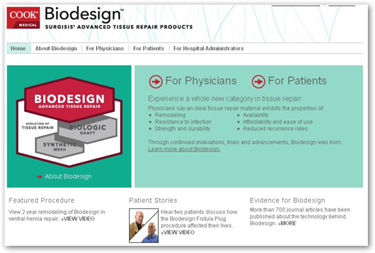What we used to think of as Star Wars is not really so any longer, it is here. I have posted about regenerative medicine quite frequently here and have a couple interviews with Cook Medical with their products that create scaffolds for body parts to grow and regenerate.
have a couple interviews with Cook Medical with their products that create scaffolds for body parts to grow and regenerate.
Knee Scaffolds Help help rebuild the Cartilage after injury – Regenerative Medicine
Regenerative Medicine and How it Works – Interview with Cook Biotech (Medical)
Cook Medical also has some online resources available.
Biologic Graft Technology Online Resources from Cook Medical – Regenerative Medicine

Earlier this year Dr. Oz visited Wake Forest.
Dr. Oz Visits a regenerative medicine lab in Wake Forest
Mentioned in the 60 Minute Report is the University of Pittsburg and this video from TED gives more details on what they are doing there with extracellular matrix ECM, and also known as pixie dust.
(CBS) It sounds like science fiction, but the fact is biotech companies and the government are pouring hundreds of millions of dollars into research they hope will one day make it possible for us to grow new body parts.
It is called regenerative medicine and the goal is to help the thousands waiting for organ transplants and the hundreds of veterans who return from Iraq and Afghanistan horribly maimed.
So far, researchers have created beating hearts, ears and bladders by manipulating cells in the human body into regrowing tissue. The hope is to one day profoundly change human lives.
Wake Forest Institute for Regenerative Medicine
McGowan Institute for Regenerative Medicine
And there's Kaitlyne McNamara, a college student who was born with Spina bifida which caused her bladder to fail. Nine years ago, Kaitlyne, along with eight other patients, received new bladders grown from their own cells outside the body.
She says the procedure changed her life. "I never even knew I could get this far. I'm just living a normal adult life."
Growing Body Parts - 60 Minutes - CBS News
Related Reading for Stem Cells




Stem cell therapy is set to become a major part of ATS, cancer, hearing loss treatments and of course plastic surgery. The need is however, is to ensure that these are stored in perfect condition before actually getting transplanted to the receiver’s body. This has made the industry of 'controlled rate freezers' to grow at a fast pace to keep up with the demand. I am doing a paper on ‘The Uses of Stem Cell Perseverance and the Techniques of Storing Them’ and found your post valuable.
ReplyDeleteCynthia Beattie Mcgill